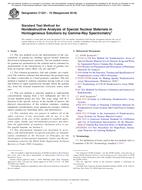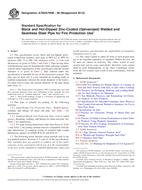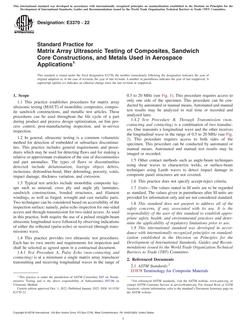Click here to purchase
1.1 Purpose-The purpose of this guide is to provide information and guidance related to the process of identifying and fulfilling continuing obligations at commercial real estate, and forestland and rural property, with respect to hazardous substances within the scope of the Comprehensive Environmental Response, Compensation and Liability Act (CERCLA) (42 U.S.C. 9601 et seq.) as well as petroleum products (collectively hereafter chemicals of concern). As such, this guide’s primary purpose is to provide information and guidance about procedures that, if completed, would help users to satisfy continuing obligations applicable to the innocent landowner, the contiguous property owner (CPO), and the bona fide prospective purchaser (BFPP) protections from CERCLA liability (hereinafter, collectively referred to as the “Landowner Liability Protections,” or “LLPs”) (see Legal Appendix X1.1 to X1.3 for an outline of CERCLA’s liability and defense provisions).
1.1.1 Continuing Obligations-Subsequent to property acquisition, the Small Business Liability Relief and Brownfields Revitalization Act of 2002 (the “Brownfields Amendments”), which amended CERCLA, requires persons (a broad term meant to cover individuals, companies, government agencies, and other entities) seeking to maintain LLPs to establish, by a preponderance of the evidence, fulfillment of certain continuing obligations. The continuing obligations set forth in the Brownfields Amendments include: (1) complying with any land use restrictions established or relied upon in connection with a response action at a property; (2) not impeding the effectiveness or integrity of any institutional controls employed at a property in connection with a response action; (3) taking reasonable steps with respect to releases of hazardous substances, including stopping continuing releases, preventing threatened future releases, and preventing or limiting human, environmental or natural resource exposure to prior releases of hazardous substances; (4) providing full cooperation, assistance and access to persons who are authorized to conduct response actions or natural resource restoration at a property; (5) complying with information requests and administrative subpoenas; and (6) providing legally required notices with respect to releases of any hazardous substances at a property.
1.1.2 Certain Continuing Obligations Not Detailed in this Guide-The procedures recommended in this guide focus on continuing obligations pertaining to land use restrictions, institutional controls, and taking reasonable steps. As noted immediately above, CERCLA lists other continuing obligations such as those related to legally required notices, allowing access, and cooperating with government regulators. These “other” continuing obligations are not further discussed in this guide. The lack of detailed treatment of these other continuing obligations, however, does not intend to suggest that they are less important or less relevant to maintaining LLPs. The user seeking additional information will find background on these other continuing obligations in Legal Appendix X1.8 to this guide.
1.1.3 Guide Does Not Provide Legal Advice-As noted above, this guide primarily intends to provide information and guidance to users who wish to perform continuing obligations for the purpose of maintaining CERCLA LLPs. To serve this purpose, this guide focuses on technical, scientific, and procedural issues involved with identifying and performing appropriate continuing obligations under site-specific circumstances. In order to explain the context for the various continuing obligations recommended in this guide, however, the guide necessarily makes reference to the statutory provisions of CERCLA. These CERCLA discussions are meant for informational purposes only and are not intended and should not be construed as legal opinions or conclusions of law; nor should any statement in this guide be relied upon as legal advice concerning CERCLA or any legal matter. The CERCLA LLPs involve complicated legal matters with potentially severe consequences. This guide is not intended to and does not replace legal advice, and should not be relied on for any legal question. No implication is intended that a person must use this guide in order to establish or maintain LLPs. Conversely, no implication is intended to assure a person using this guide of success against CERCLA liability when using this guide. The user is encouraged to seek legal advice when seeking to establish and maintain CERCLA liability defenses. In a number of sections throughout the guide, the guide notes instances where legal issues are particularly relevant and often reinforces the guide?s overall recommendation to seek the advice of legal counsel concerning CERCLA LLPs. Where particular sections do not suggest the need for legal advice, no implication is intended that legal advice is not recommended or warranted.
1.1.4 Inclusion of Petroleum Products-Petroleum products are included within the scope of this guide because they are often of concern at commercial real estate. Although petroleum products enjoy a limited exclusion from CERCLA liability, current custom and usage generally includes an evaluation of whether petroleum products may be present on commercial real estate during pre-acquisition environmental site assessments. Thus, this guide likewise includes petroleum products within its scope. The actions discussed in this guide could be useful or prudent if applied at commercial real estate affected by a release of petroleum products.
1.1.5 Applicability to Non-CERCLA Properties-While this guide is primarily intended to address CERCLA LLPs, it need not be limited exclusively for that purpose. The procedures described in this guide may prove prudent at properties where Activity and Use Limitations (AULs) or environmental contamination exists, even though CERCLA LLPs may not be of concern. AULs are employed at many properties remediated under state or non-CERCLA federal programs where CERCLA liability may not be of concern but, nonetheless, the AUL and reasonable step procedures recommended by this guide may provide useful procedures for assuring AUL compliance. For example, Michigan state law sets “due care” requirements for purchasers of contaminated properties, mandating that they perform various post-purchase duties including, among others, complying with and not impeding the effectiveness and integrity of AULs, and preventing exacerbation and mitigating unacceptable exposure of hazardous substances. Also, for example, Wisconsin sets legal rules and administrative guidance covering certain continuing obligations for AULs.
1.1.6 Activity and Use Limitations, Institutional Controls, Engineering Controls, and Land Use Restrictions-The term Activity and Use Limitation (AUL) is taken from Guide E2091 to include both legal controls (that is, institutional controls) and physical controls (that is, engineering controls) within its scope. Agencies, organizations, and jurisdictions, however, may define or utilize these terms differently. For example, the term “land use controls” is used by the Department of Defense and the term land use restrictions is used but not defined in the Brownfields Amendments. CERCLA, as amended by the Brownfields Amendments, expressly prescribes continuing obligations only for institutional controls (ICs) and land use restrictions (LURs), each of which represents a subset of the term AUL. In addition to land use restrictions and institutional controls, additional types of AULs, particularly engineering controls, may exist at a property. While broadly a type of AUL, engineering controls could also be required by or be associated with ICs or LURs. Where this guide directly addresses the continuing obligations for AULs set forth in CERCLA, it uses the statutory terms land use restrictions and institutional controls to maintain consistency with CERCLA. Where this guide refers generally to AULs, this guide employs the term AUL. Although certain continuing obligations expressly refer to land use restrictions and institutional controls, the broader set of continuing obligations (such as taking reasonable steps to address releases of chemicals of concern) require a consideration of all AULs, including engineering controls.
1.1.7 Properties Covered-In addition to property with AULs, the procedures suggested by this guide are primarily intended to cover property where chemicals of concern are known to have been (1) released on the property prior to acquisition by the current property owner (2) are present at the property after acquisition by the current property owner, due to the migration from neighboring property, or (3) are discovered after property transfer where the Phase I (or other methods of performing AAI), though properly performed, provided no reason to know of the presence of chemicals of concern. This guide focuses on these release situations because such situations tend to give rise to circumstances in which one or more of the CERCLA LLPs could apply. See Legal Appendix X1.3 for additional discussion of CERCLA LLPs.
1.1.8 Recognized Environmental Conditions-For the purposes of this guide, the term recognized environmental condition is defined in the same manner as the term is defined in Practices E1527 and E2247, which provide guidance for the Phase I environmental site assessment process (hereafter Phase I). REC means the presence or likely presence of any chemical of concern on a property under conditions that indicate an existing release, a past release, or a material threat of a release of any chemicals of concern into structures on the property or into the ground, groundwater, or surface water on the property. RECs do not include de minimis conditions that do not generally present a threat to human health or the environment and which would not generally be the subject of an enforcement action if brought to the attention of the appropriate governmental agencies.
1.1.9 Presumption of All Appropriate Inquiries and Desire to Qualify for LLPs-This guide is primarily intended for users who seek to qualify for any LLPs. Therefore, this guide presumes that its users have performed or will perform a currently valid Phase I or otherwise satisfy “all appropriate inquiries” prior to acquisition of the property.
1.1.10 Timing-Subject to the other scope considerations described in this section, the procedures in this guide are intended to be applicable when a user knows or has reason to know, after the user?s purchase of the property, that chemicals of concern either (1) have been released at the property or (2) may be released in the future. Therefore, for users who purchase property where RECs have been identified, this guide is meant to apply upon property purchase. Users who have gained knowledge or reason to know of property releases of chemicals of concern prior to the publication of this guide (for example, where a user purchased contaminated property years before this guide was published) may still use this guide. Such users may need to reconsider and update the findings and conclusions in any existing Phase I (or alternative all appropriate inquiries efforts) in order to fully utilize this guide. See 5.2.2 (addressing presumption of currently valid Phase I/AAI).
1.1.11 Determination of No Continuing Obligations Related to Activity and Use Limitations and Reasonable Steps-Section 5 of this guide recommends a procedure for considering whether continuing obligations covered by this guide are required or applicable to the property. Refer to 1.1.2 for a summary of continuing obligations that are not addressed in detail by this guide. As addressed in more detail in Section 5, a determination that no continuing obligations are required can be made where neither RECs, institutional controls, nor land use restrictions exist, and user?s otherwise have no knowledge to indicate the presence of chemicals of concern at the property. Even where a Phase I (or all appropriate inquiries) found RECs, further evaluation (see Section 6) can justify a conclusion that no chemicals of concern were released and, in turn, this conclusion can justify a determination of no continuing obligations. See 5.4, however, discussing the case where future circumstances could arise that would cause users to reevaluate determinations that no continuing obligations are required.
1.1.12 CERCLA Requirements Other Than Continuing Obligations-This guide does not provide guidance on requirements other than continuing obligations that may be necessary to retain eligibility for LLPs or other CERCLA defenses. See Legal Appendix X1.3 for discussion of CERCLA LLPs and other CERCLA defenses.
1.1.13 Other Federal, State, and Local Environmental Laws-Users are cautioned that federal, state, and local laws may impose environmental assessment, remedial action, or other obligations related to hazardous substances or petroleum products that are beyond the scope of this guide.
1.1.14 Documentation-CERCLA requires that a user seeking to retain eligibility for an LLP must demonstrate compliance with continuing obligations by a preponderance of evidence. There is no apparent requirement for written documentation to demonstrate compliance with continuing obligations, but written documentation could be useful and, perhaps even essential, in cases where a user desires to demonstrate the performance of continuing obligations. The guide provides guidance in Section 9 on the preparation of continuing obligation plans and suggests procedures for documenting continuing obligation efforts. Users are encouraged to consult with legal counsel on steps to be taken to document compliance with continuing obligations.
1.2 Objectives-This guide establishes the following objectives: (1) provide information and guidance related to procedures to identify and comply with continuing obligations on commercial real estate or on forest or rural land; and (2) formulate and clarify suggested industry methods and procedures for identifying and satisfying continuing obligations that are practical, efficient and reasonable.
1.3 Organization of this Guide-This guide has nine sections and eight appendices. Fig. 1 provides a representation of this guide as a flowchart, and represents decision points for the user as the guidance is applied:
Section 1 is the Scope.
Section 2 lists Referenced Documents.
Section 3, Terminology, contains definitions of terms used in this guide, definitions of terms unique to this guide and acronyms.
Section 4 discusses the Significance and Use of this guide.
Section 5 discusses Step 1, a screening process relying on the Phase I to help determine whether continuing obligations apply to the property.
Section 6 discusses Step 2, a process for evaluating the environmental conditions and AULs that may affect the property in advance of planning for continuing obligations.
Section 7 discusses Step 3, providing guidance for a process to select continuing obligations to be performed under site-specific circumstances.
Section 8 discusses Step 4, providing guidance for a process to select and schedule monitoring requirements for continuing obligations.
Section 9 offers guidance on documentation for (1) statements of no continuing obligations on a property, (2) a continuing obligations plan , and (3) reporting the periodic monitoring of continuing obligation.
The Appendices provide additional information:
Appendix X1 (the Legal Appendix) describes liability and defenses to liability under CERCLA, as amended by the Brownfields Amendments, while also providing important discussion on continuing obligations.
Appendix X2 provides a recommended table of contents and report format for a statement of no continuing obligations.
Appendix X3 provides a representative form for a statement of no continuing obligations.
Appendix X4 provides a recommended table of contents and report format for a continuing obligations plan.
Appendix X5 provides a recommended table of contents and report format for a continuing obligations monitoring and evaluation report.
Appendix X6 provides a representative form for continuing obligations field investigation, for a simple site.
Appendix X7 provides a representative form for continuing obligations field investigation, for a more complex site.
Appendix X8 develops five scenarios to assist in the application of this guide.
1.4 This standard does not purport to address all of the safety concerns, if any, associated with its use. It is the responsibility of the user of this standard to establish appropriate safety and health practices and determine the applicability of regulatory limitations prior to use.
1.5 This guide offers guidance on performing one or more specific tasks and should be supplemented by education, experience and professional judgment. Not all aspects of this guide may be applicable in all circumstances. This guide does not necessarily represent the standard of care by which the adequacy of a given professional service must be judged, nor should this document be applied without consideration of a property?s unique aspects. The word “standard” in the title means only that the document has been approved through the ASTM consensus process.
Note-Continuing obligations may be triggered based in the future as discussed in 5.4.1. Other obligations may exist as discussed in 5.4.2.
Product Details
- Published:
- 05/15/2011
- Number of Pages:
- 50
- File Size:
- 1 file , 580 KB


